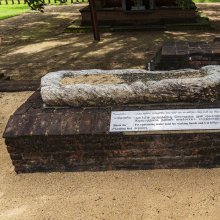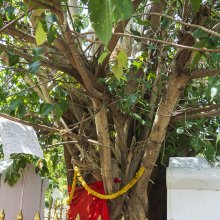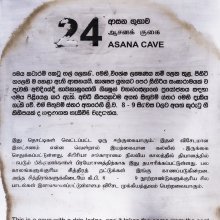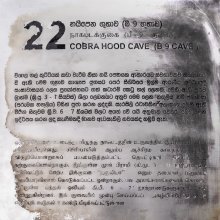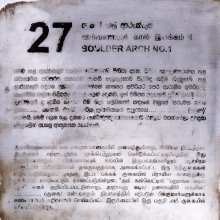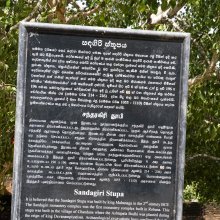Pera, Pēra: 13 definitions
Introduction:
Pera means something in Hinduism, Sanskrit, Marathi, Jainism, Prakrit, biology. If you want to know the exact meaning, history, etymology or English translation of this term then check out the descriptions on this page. Add your comment or reference to a book if you want to contribute to this summary article.
Images (photo gallery)
(+1 more images available)
Biology (plants and animals)
Source: Wisdom Library: Local Names of Plants and DrugsPera in the Malayalam language is the name of a plant identified with Psidium guajava L. from the Myrtaceae (Bottlebrush) family having the following synonyms: Psidium fragrans, Psidium pomiferum, Psidium cujavus. For the possible medicinal usage of pera, you can check this page for potential sources and references, although be aware that any some or none of the side-effects may not be mentioned here, wether they be harmful or beneficial to health.
Source: Google Books: CRC World Dictionary (Regional names)1) Pera in Central and South America is the name of a plant defined with Syzygium malaccense in various botanical sources. This page contains potential references in Ayurveda, modern medicine, and other folk traditions or local practices It has the synonym Jambosa macrophylla (Lam.) DC. (among others).
2) Pera in India is also identified with Careya arborea It has the synonym Careya arborea Roxb. & Roxb. (etc.).
3) Pera is also identified with Psidium guajava It has the synonym Syzygium ellipticum K. Schum. & Lauterb. (etc.).
Example references for further research on medicinal uses or toxicity (see latin names for full list):
· Linnaea (1856)
· Mus. Bot. (1850)
· Interpret. Rumph. Herb. Amb. (1917)
· Loefgrenia (1976)
· Prodromus Systematis Naturalis Regni Vegetabilis (1828)
· Biologia Centrali-Americana; … Botany (1880)
If you are looking for specific details regarding Pera, for example health benefits, chemical composition, diet and recipes, pregnancy safety, extract dosage, side effects, have a look at these references.

This sections includes definitions from the five kingdoms of living things: Animals, Plants, Fungi, Protists and Monera. It will include both the official binomial nomenclature (scientific names usually in Latin) as well as regional spellings and variants.
Languages of India and abroad
Marathi-English dictionary
Source: DDSA: The Molesworth Marathi and English Dictionarypēra (पेर).—n (parva S) An articulation or a joint: also the portion included betwixt two, an internodation. 2 A disease attacking the finger-ends.
--- OR ---
pēra (पेर).—m (pēraṇēṃ To sow.) Casting ricestalks &c. upon the thrashing floor for the ears to be trodden out by oxen: also the material so cast. v ghāla. 2 (Laxly, with the hyperbolical conceit of Sowing.) Spreading abroad; tossing and throwing about (of grain, flowers, papers, clothes); any wasteful or profuse strewing, scattering, shedding, spilling. v ghāla, kara, paḍa, hō. Also the things thus spread or strewn. 3 f Sowing seed. Pr. pēra tasēṃ phaḷa.
--- OR ---
pēra (पेर).—f C (Commonly pērū) The Guava-tree, and n Its fruit.
--- OR ---
pērā (पेरा).—m An operation of goldsmiths,--moulding the bar (of gold) into cylindrical wires (in preparation for rings &c.)
Source: DDSA: The Aryabhusan school dictionary, Marathi-Englishpēra (पेर) [-rēṃ, -रें].—n Joint. An internodation. A di- sease attacking the finger-ends.
Marathi is an Indo-European language having over 70 million native speakers people in (predominantly) Maharashtra India. Marathi, like many other Indo-Aryan languages, evolved from early forms of Prakrit, which itself is a subset of Sanskrit, one of the most ancient languages of the world.
Sanskrit dictionary
Source: DDSA: The practical Sanskrit-English dictionaryPerā (पेरा).—A kind of musical instrument (= kharamukhākāravādyam); पूर्णाः पेराश्च सस्वनुः (pūrṇāḥ perāśca sasvanuḥ) Bhaṭṭikāvya 14.3; पेराश्चापूरयन् कलाः (perāścāpūrayan kalāḥ) 17.7.
Source: Cologne Digital Sanskrit Dictionaries: Shabda-Sagara Sanskrit-English DictionaryPerā (पेरा).—f.
(-rā) A kind of musical instrument. E. pi vā re .
Source: Cologne Digital Sanskrit Dictionaries: Benfey Sanskrit-English DictionaryPerā (पेरा).—f. A musical instrument.
Source: Cologne Digital Sanskrit Dictionaries: Cappeller Sanskrit-English DictionaryPerā (पेरा).—[feminine] a cert. musical instrument.
Source: Cologne Digital Sanskrit Dictionaries: Monier-Williams Sanskrit-English DictionaryPerā (पेरा):—f. a kind of musical instrument, [Bhaṭṭi-kāvya]
[Sanskrit to German]
Sanskrit, also spelled संस्कृतम् (saṃskṛtam), is an ancient language of India commonly seen as the grandmother of the Indo-European language family (even English!). Closely allied with Prakrit and Pali, Sanskrit is more exhaustive in both grammar and terms and has the most extensive collection of literature in the world, greatly surpassing its sister-languages Greek and Latin.
Prakrit-English dictionary
Source: DDSA: Paia-sadda-mahannavo; a comprehensive Prakrit Hindi dictionaryPera (पेर) in the Prakrit language is related to the Sanskrit word: Prera.
Prakrit is an ancient language closely associated with both Pali and Sanskrit. Jain literature is often composed in this language or sub-dialects, such as the Agamas and their commentaries which are written in Ardhamagadhi and Maharashtri Prakrit. The earliest extant texts can be dated to as early as the 4th century BCE although core portions might be older.
Kannada-English dictionary
Source: Alar: Kannada-English corpusPera (ಪೆರ):—[adjective] (in comp.) other; different; another.
--- OR ---
Pera (ಪೆರ):—[adjective] (in comp.) of, at or in the rear.
--- OR ---
Peṟa (ಪೆಱ):—[adjective] (in comp.) other; different; another.
--- OR ---
Peṟa (ಪೆಱ):—[adjective] (in comp.) of, at or in the rear.
Kannada is a Dravidian language (as opposed to the Indo-European language family) mainly spoken in the southwestern region of India.
See also (Relevant definitions)
Starts with (+144): Per-anmullai, Per-anvanci, Per-arulalan, Per-arulutaimai, Pera de agua, Pera japonesa, Pera melon, Pera muttiver, Pera-ratta, Pera-rattai, Pera-virai, Peraalu, Peraamutti, Perabhaga, Perabisi, Peracai, Peraciriyar, Peracon, Peradda, Peraddoni.
Ends with (+21): Acalypha supera, Achyranthes aspera, Aeschynomene afraspera, Aeschynomene aspera, Andrachne aspera, Aphananthe aspera, Arrupera, Attapera, Attupera, Bacche di vipera, Byttneria aspera, Cleome aspera, Copaifera paupera, Eragrostis aspera, Grewia aspera, Hadapera, Javadipera, Kattupera, Kheperȧ, Kipera.
Full-text (+18): Perani, Melon pera, Pehara, Peharani, Pera melon, Pera-ratta, Pera de agua, Peharanem, Pera japonesa, Botaca-sandha, Pera-virai, Pera muttiver, Pera-rattai, Natuppera, Datapatala, Tanippera, Prera, Arupatankottai, Perakem, Yappatikaram.
Relevant text
Search found 6 books and stories containing Pera, Pēra, Pērā, Perā, Peṟa; (plurals include: Peras, Pēras, Pērās, Perās, Peṟas). You can also click to the full overview containing English textual excerpts. Below are direct links for the most relevant articles:
Tiruvaymoli (Thiruvaimozhi): English translation (by S. Satyamurthi Ayyangar)
The Religion and Philosophy of Tevaram (Thevaram) (by M. A. Dorai Rangaswamy)
Chapter 3 - The final goal < [Volume 4.2.3 - Philosophy of God]
Srila Gurudeva (The Supreme Treasure) (by Swami Bhaktivedanta Madhava Maharaja)
At the Guest House < [Chapter 2.5 - Their Intimacy Could Not Have Been Greater]
A Brief History (Intrview at the Śrī Rādhā-rāmaṇa Temple) < [Chapter 2.8 - Our Lasting Relationship]
Telugu Literature under Kutub Shahis < [April-June 1942]
Hindu Pluralism (by Elaine M. Fisher)
The sites of Multilingual Literary production in Nāyaka-period South India < [Chapter 4 - The Language Games of Śiva]
Kathasaritsagara (the Ocean of Story) (by Somadeva)
Introduction to the tradition of Betel-chewing < [Appendix 8.2 - The Romance of Betel-Chewing]
